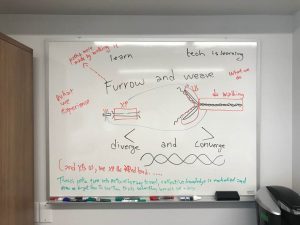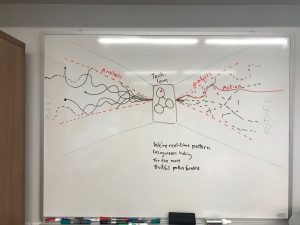Hey everyone, Mackenzie here.
I’m going to respond to a set of 2 ideas that drew my attention, and I’m going to synthesize what I think ETEC 540 Text Technologies is about.
I’ll be doing it in 3 videos:
- Analysis: https://www.youtube.com/watch?v=X8xbR0fNWxQ
- Forecasting: https://www.youtube.com/watch?v=1I5PD5dt-Ys
- Synthesis: https://youtu.be/IpySYlLZbGM
The first two videos each deal with a salient idea, while the last video synthesizes these ideas into what I think it means for us as educational technologists.
I’ve opted to continue using a talking head format because it’s great practice for speaking: it’s amazing how many “ums” and “ahs” I’ve got going on in my orality. This is a way to fix that, and really thinking before I speak.
There’s also a set of skills involved in the process that will come in handy when I need to interview people for work projects.
In addition to these learning considerations, I also think that this program benefits from visibly human interaction, which in our online courses is noticeably absent.
This time around, my camera was stable (I had access to a tripod and a camcorder). The drawback was that the camera I was using made ginormous video files: they were gigabytes. My goodness, that took a very long time to produce these very simple videos, and I stayed up into the wee hours ensuring production went well. I’ll certainly be using my iPhone from now on, I’ll just need to find a tripod solution for it.
It’s been a pleasure ETEC 540
All the best,
Mackenzie
Edit (August 7, 2018):
Context:
I found it tricky to summarize what I learned in this course, because I learned a lot. The videos above are an abstract overview of the structure of the course, but I have many unfinished thoughts that are still swirling around my head.
For instance, I’ve been shadow boxing Heidegger’s The Question concerning Technology since I researched his claims vis-a-vis history for an ETEC 511 assignment (something about his historical examples really rankled with the extensive [amateur] historical research I’ve done). This course has given me additional tools with which to refute/re-examine Heidegger’s claims (rip.mix.feed).
In reading the content of this course and outside papers, I can see his impact on many of the authors. For instance, McLuhan seems to buttress Heidegger’s work: the “enframing” of Heidegger has become the “typographic” mindset of McLuhan. I also think that Postman borrows extensively from Heideggerian thought, or at least echoes his sentiments: enframing becomes “technopoly.”
Postman himself seems to be following some kind of trend in the 90s that saw books like A is for Ox: The collapse of literacy and the rise of violence in an electronic age and ABC: The alphabetization of the popular mind. Both of these books seem to be alarmist (I’ve not yet read them as I received them from the resident storyteller at the hospital I work at in the midst of completing my documentary), perhaps influenced by the financial stress-induced malaise of the 1980s, or perhaps, as with popular music, influenced by the disorienting effects of the slowly-growing digital revolution.
Facebook post (pre-documentary):
I posted some initial thoughts about my (still unformed) documentary to Facebook. For some reason, I feel compelled to share the process of struggling with academic items. Here’s the post:
My brain absorbs and synthesizes. Yours does too. When we “learn” something it becomes a smorgasbord automatically: as we experience something we make linkages between the new things we experience and the old things we’ve experienced (or at least remembrances of them…remembrances which are always necessarily themselves informed by linkages with intermediating experiences. We wrap all of this in the tidy and infinitely more understandable label of “learning.”
Then comes the formal education/scholar process: use meta-cognition to float above the fray of this (very messy, very organic) process and discern patterns. Then distill these patterns using some semblance of rationality, an intermediary material to share with others (e.g., text, video) and proper presentation etiquette (e.g., grammar, spelling, visual design, layout, paragraphs, sound effects).
***
UBC Course: synthesize your ideas about the content of this course or respond to a salient idea, or set of ideas, that drew your attention
Me: Characterize writing as technology and you are equipped with a maximally lengthened exploration of the ramifications of the natural experiments of history that expose the relationship between homo-sapiens and its artifices.
This relationship is a reflexive relationship whereby homo-sapiens creates technology, and technology feeds back and changes homo-sapiens, which then changes technology…etc…
This happens on multiple levels: psychology is impacted by the shift from orality to writing, the communication and information structures of society are impacted, which is implicated in wider changes in areas as disparate as economics, war, family relations, etc.
Due to the non-linear (yet perhaps helical?) nature of this relationship, technological determinism is laid bare as an incorrect supposition. Technology, born out of the context of historicity–which is to say, historical accident and chance–evolves with its environment. This environment includes us, and we actively participate in directly tinkering with the DNA of this evolving hodgepodge entity.
UBC Course: explain by creating a multimedia production in a format of your choosing…
Me: *rubs hands together, breathes deeply…*
I also posted this image and explanatory text, with (coming back to my nemesis, Heidegger) an overall conception of technology, learning, and our relationship to technology (you may have seen a reproduction of this image on the whiteboard in my videos):
Heidegger, even incidentally, you’re still wrong, lol.
The blue arrows: the experience of furrowing operates as the “us” in weaving (separate items are brought together); the thread/item we’ve made in weaving constitutes the “us” in furrowing that divides a whole entity into separate parts. The two have a reflexive relationship (one cannot be said to have caused the other, but they do both cause one another in a feedback process).
Top: The root of ‘learn’ means ‘furrow’ or ‘track’; the root of ‘tech’ and ‘text’ means ‘to weave’ or ‘to make’.
Bottom: Divergent-convergent thinking is a design model developed in UK healthcare.
Walking example: we walk the land, as we walk the land “remembers” our actions; we see this remembrance and reinforce past tracks. Eventually this changes the way we see the land itself, and we can follow tracks/paths mindlessly and devote our pattern-recognition abilities to other spheres (like building empires and spaceships).

Photo in phone (pre-documentary)
Towards the end of this process of digesting via whiteboard (and I think whiteboards, blackboards and sticky notes are still the best technology at this stage, definitely not computers, which are visually and tactile-ly restrictive; unlined paper is a close second, but I like the scale of boards…the bigger the better) I developed this diagram, a diagram that became the blueprint for first my script, then my video:

Wow, that’s a grainy image….essentially the left is the past, the right is the future. The squiggly lines are the paths of phenomenon we’ve recognized as patterns/paths; the green lines framing these squiggly lines represent our overall view of the past and future. In the centre, a lens of three items (us, context, technology) are inter-connected (by lens, I mean a compound lens, such as a microscope).
Later on, I also introduced an insertion right at the lens-future divide and called it “call to action.” I intended this to be the third video, referring to thoughts I shared about the New London Group in my post, Technological forecasting in situ (namely that they were telling people to get it together and change the world, rather than sitting on technological determinism and thinking the world’s problems would go away on their own/through technology).
Extracurricular research (pre- and post-documentary)
Lastly, I’d like to share a quote from a book I can’t put down called The origins of totalitarianism. I’ve been reading this book for a few weeks now, and feature it (and a excerpt from it) in my Rip.Mix.Feed. Here’s another quote that really struck me as salient. To me, it represents part of the reason technological determinism–at least from my vantage–runs rampant through society:
“This process of never ending accumulation of power necessary for the protection of the never ending accumulation of capital determined the ‘progressive’ ideology of the late 19th century and foreshadowed the rise of imperialism. Not the naïve delusion of a limitless growth of property, but the realization that power accumulation was the only guarantee for the stability of so-called economic laws, made progress irresistible. The 18th century notion of progress, as conceived in pre-revolutionary France, intended criticism of the past to be a means of mastering the present and controlling the future; progress culminated in the emancipation of man. But this notion had little to do with the endless progress of bourgeoisie society, which not only did not want the liberty and autonomy of man, but was ready to sacrifice everything and everybody to supposedly super human laws in history. ‘What we call progress is [the] wind…That drives [the angel of history] irresistibly into the future to which he turns his back while the pile of ruins before him towers to the skies.’ Only in Marx’s dreams of a classless society which, in Joyce’s words, was to awaken mankind from the nightmare of history, does the last, although utopian, trace of the 18th century concept appear.”
-Hannah Arendt, ‘The Origins of Totalitarianism,’ pg. 143

